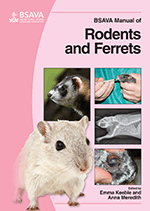
Full text loading...

Clinical signs associated with dermatological disease in rodents are similar to those in other mammal species, as are aetiological categories and diagnostic investigations. It is important to acquire full husbandry details, including environmental conditions and diet. Bedding materials are often irritant, and even if both the primary cause may contribute to a worsening of clinical signs. A medical history should also be obtained. Clinical signs of in-contact animals may be significant. Dermatoses may be associated with generalized problems. A physical examination should be performed, though it may be cursory in small species. The entire integument is examined, including the extremities. At this stage, a list of differential diagnoses should be formed, allowing the veterinary surgeon to select appropriate investigative techiniques. This chapter looks at Bacterial disease; Fungal disease; Parasitic disease; Viral disease; Environmental disease; Behavioural disease and Miscellaneous skin disease in mice, rats, hamsters, gerbils, guinea pigs, chinchillas and degus.
Rodents: dermatoses, Page 1 of 1
< Previous page | Next page > /docserver/preview/fulltext/10.22233/9781905319565/9781905319565.10-1.gif

Full text loading...













